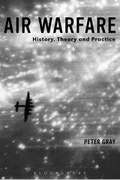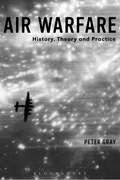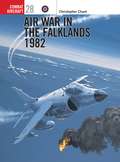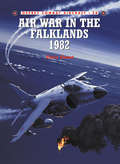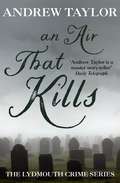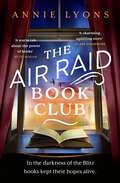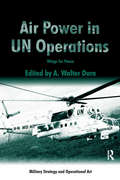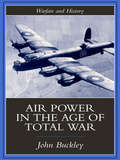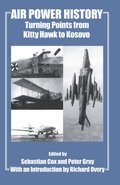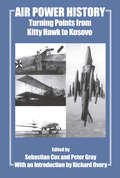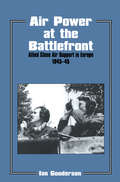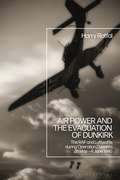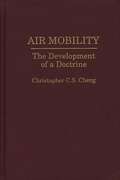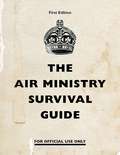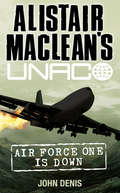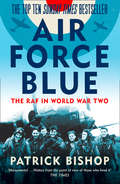- Table View
- List View
Air Warfare: History, Theory And Practice (PDF)
by Peter GrayAir Warfare provides an introduction to the subject's theory, history and practice. As well as delivering an up to date look at the strategy, and historiography of air power, Peter Gray explores the theories behind air power and looks at the political, legal and moral dimensions of the application of air power. Topics covered include: - Key military strategists and their legacy - Air power's strategic effects - Leadership, management and command - Tactics, technology and operations The book draws on primary sources including official narratives and published reports, examines key thinkers in the study of air power, and discusses topics such as concepts of warfare as an art or science, cultural perceptions of air power, and the experience of being an airman. With its broad scope and thorough coverage of a range of key topics, Air Warfare takes air power beyond the study of individual campaigns, or controversies, providing a multi-disciplinary approach to air power studies.
Air Warfare: History, Theory and Practice
by Peter GrayAir Warfare provides an introduction to the subject's theory, history and practice. As well as delivering an up to date look at the strategy, and historiography of air power, Peter Gray explores the theories behind air power and looks at the political, legal and moral dimensions of the application of air power. Topics covered include: - Key military strategists and their legacy - Air power's strategic effects - Leadership, management and command - Tactics, technology and operations The book draws on primary sources including official narratives and published reports, examines key thinkers in the study of air power, and discusses topics such as concepts of warfare as an art or science, cultural perceptions of air power, and the experience of being an airman. With its broad scope and thorough coverage of a range of key topics, Air Warfare takes air power beyond the study of individual campaigns, or controversies, providing a multi-disciplinary approach to air power studies.
Air Warfare: History, Theory and Practice
by Peter GrayAir Warfare provides an introduction to the subject's theory, history and practice. As well as delivering an up to date look at the strategy, and historiography of air power, Peter Gray explores the theories behind air power and looks at the political, legal and moral dimensions of the application of air power. Topics covered include: - Key military strategists and their legacy - Air power's strategic effects - Leadership, management and command - Tactics, technology and operations The book draws on primary sources including official narratives and published reports, examines key thinkers in the study of air power, and discusses topics such as concepts of warfare as an art or science, cultural perceptions of air power, and the experience of being an airman. With its broad scope and thorough coverage of a range of key topics, Air Warfare takes air power beyond the study of individual campaigns, or controversies, providing a multi-disciplinary approach to air power studies.
Air War in the Falklands 1982 (Combat Aircraft)
by Mark Rolfe Chris ChantThe war fought between the United Kingdom and Argentina in 1982, for the possession of the Falkland Islands was probably the last 'colonial' war that will ever be undertaken by the British. This book shows how the key to British success was the speed with which the British gained and then maintained air superiority over the islands and the waters around then with their small force of Sea Harrier STOVL warplanes, which operated from two aircraft carriers. Though subsonic, the Sea Harrier and its Sidewinder AAM were a combination altogether superior to Argentina's mix of supersonic and subsonic warplanes with older weapons, and this advantage was emphasised by the significantly greater tactical acuity of the British pilots. The Argentine pilots fought with considerable piloting skill and enormous courage, and scored a number of stunning successes against British warships, but ultimately they could not prevent the British landing and the following land campaign that resulted in complete Argentine defeat.
Air War in the Falklands 1982 (Combat Aircraft #28)
by Mark Rolfe Chris ChantThe war fought between the United Kingdom and Argentina in 1982, for the possession of the Falkland Islands was probably the last 'colonial' war that will ever be undertaken by the British. This book shows how the key to British success was the speed with which the British gained and then maintained air superiority over the islands and the waters around then with their small force of Sea Harrier STOVL warplanes, which operated from two aircraft carriers. Though subsonic, the Sea Harrier and its Sidewinder AAM were a combination altogether superior to Argentina's mix of supersonic and subsonic warplanes with older weapons, and this advantage was emphasised by the significantly greater tactical acuity of the British pilots. The Argentine pilots fought with considerable piloting skill and enormous courage, and scored a number of stunning successes against British warships, but ultimately they could not prevent the British landing and the following land campaign that resulted in complete Argentine defeat.
An Air That Kills: The Lydmouth Crime Series Book 1 (Lydmouth Crime Series #1)
by Andrew Taylor'Andrew Taylor is a master story-teller' Daily TelegraphFrom the No.1 bestselling author of The Ashes of London and Fire of Court, this is the first instalment in the acclaimed Lydmouth seriesWorkmen in the small market town of Lydmouth are demolishing an old cottage. A sledgehammer smashes into what looks like a solid wall. Instead, layers of wallpaper conceal the door of a locked cupboard which holds a box - and in the box is the skeleton of a young baby. Items within the box suggest that the baby was entombed early in the nineteenth century, but when another man is also found dead, the evidence suggests that the baby's death is more recent and that a killer is on the loose. For Journalist Jill Francis, newly arrived from London, this looks like her first story to chase ... 'The most under-rated crime writer in Britain today' Val McDermid'Captures perfectly the drab atmosphere and cloying morality of the 1950s . . . Taylor is an excellent writer. He plots with care and intelligence and the solution to the mystery is satisfyingly chilling' The Times 'There is no denying Taylor's talent, his prose exudes a quality uncommon among his contemporaries' Time Out 'Andrew Taylor is a master story-teller' Daily Telegraph
Air-sea rescue helicopter (UEB Uncontracted)
by RnibThe helicopter is viewed from the side with only one of its main wheels showing at the lower centre of the page, and with a tail wheel to its right. There is a locator dot shown, which will be at the top left of the page when the image is the right way up. The cockpit at the front is on the left of the page and the tail on the right. The long rotor blades stretch from the left of the page to the right, above the helicopter body. On the left of the body there are three cockpit windows, up from these is the engine grill. Up from the main wheel one of the helicopter's floats is shown and two more windows. To the right of these is the open hatch through which people are winched during rescue missions. Right from the hatch is another window. Above the hatch and single window is the radar dome on the top edge of the helicopter. At the far right of the page is the six bladed tail rotor.
Air-sea rescue helicopter (UEB Contracted)
by RnibThe helicopter is viewed from the side with only one of its main wheels showing at the lower centre of the page, and with a tail wheel to its right. There is a locator dot shown, which will be at the top left of the page when the image is the right way up. The cockpit at the front is on the left of the page and the tail on the right. The long rotor blades stretch from the left of the page to the right, above the helicopter body. On the left of the body there are three cockpit windows, up from these is the engine grill. Up from the main wheel one of the helicopter's floats is shown and two more windows. To the right of these is the open hatch through which people are winched during rescue missions. Right from the hatch is another window. Above the hatch and single window is the radar dome on the top edge of the helicopter. At the far right of the page is the six bladed tail rotor.
Air-sea rescue helicopter (Large Print)
by RnibThe helicopter is viewed from the side with only one of its main wheels showing at the lower centre of the page, and with a tail wheel to its right. There is a locator dot shown, which will be at the top left of the page when the image is the right way up. The cockpit at the front is on the left of the page and the tail on the right. The long rotor blades stretch from the left of the page to the right, above the helicopter body. On the left of the body there are three cockpit windows, up from these is the engine grill. Up from the main wheel one of the helicopter's floats is shown and two more windows. To the right of these is the open hatch through which people are winched during rescue missions. Right from the hatch is another window. Above the hatch and single window is the radar dome on the top edge of the helicopter. At the far right of the page is the six bladed tail rotor.
The Air Raid Book Club: This uplifting World War 2 historical novel is the perfect gift for book lovers
by Annie Lyons'Touching and heartwarming . . . get those tissues ready' - Jill Mansell'A warm and tender tale about the power of books' - Ruth HoganAs the bombs began to fall, the book club kept their hopes alive...London, 1938. Bookseller Gertie Bingham is facing difficult times, having just lost her beloved husband, Harry, and with a lingering sadness at never having been able to have a child of her own. Struggling to face running the bookshop she and Harry opened together, Gertie is preparing to sell up and move away when she is asked if she would be willing to take in a young Jewish refugee from Germany. Gertie is unsure and when sullen teenager Hedy Fischer arrives, Gertie fears she has nothing left to give the troubled girl. But when the German bombers come and the lights go out over London, Gertie and Hedy realise that joining forces will make them stronger, and that books have the power to bring young and old together and unite a community in need in its darkest hour...Readers adore The Air Raid Book Club:'I loved this . . . a sweet and nourishing ode to books that historical fiction fans will love' - Kate Thompson 'A charming, uplifting story of resourceful women and the healing power of books' - Clare Chambers'Tender, touching and utterly heart-warming' - Sarah Steele'A wonderful story of strong female friendship and found family . . . I absolutely adored it' - ⭐ ⭐ ⭐ ⭐ ⭐ Real reader review'Beautiful and moving in a way that we need right now' - ⭐ ⭐ ⭐ ⭐ ⭐ Real reader review'A beautiful depiction of a community striving to survive together' - ⭐ ⭐ ⭐ ⭐ ⭐ Real reader review'A gentle, heartwarming read' - ⭐ ⭐ ⭐ ⭐ ⭐ Real reader review
Air Power in UN Operations: Wings for Peace (Military Strategy and Operational Art)
by A. Walter DornAir power for warfighting is a story that's been told many times. Air power for peacekeeping and UN enforcement is a story that desperately needs to be told. For the first-time, this volume covers the fascinating range of aerial peace functions. In rich detail it describes: aircraft transporting vital supplies to UN peacekeepers and massive amounts of humanitarian aid to war-affected populations; aircraft serving as the 'eyes in sky' to keep watch for the world organization; and combat aircraft enforcing the peace. Rich poignant case studies illuminate the past and present use of UN air power, pointing the way for the future. This book impressively fills the large gap in the current literature on peace operations, on the United Nations and on air power generally.
Air Power in UN Operations: Wings for Peace (Military Strategy and Operational Art)
by A. Walter DornAir power for warfighting is a story that's been told many times. Air power for peacekeeping and UN enforcement is a story that desperately needs to be told. For the first-time, this volume covers the fascinating range of aerial peace functions. In rich detail it describes: aircraft transporting vital supplies to UN peacekeepers and massive amounts of humanitarian aid to war-affected populations; aircraft serving as the 'eyes in sky' to keep watch for the world organization; and combat aircraft enforcing the peace. Rich poignant case studies illuminate the past and present use of UN air power, pointing the way for the future. This book impressively fills the large gap in the current literature on peace operations, on the United Nations and on air power generally.
Air Power in the Age of Total War (Warfare and History Ser. #(PDF))
by John BuckleyA fascinating study of the changing military role of air power in the 20th century, this book examines the sensational impact of the Great War, the pioneering work of air power theorists and visionaries in the interwar period, the air arms race, the Second World War in Europe and the Far East, and, finally, the post-war period.
Air Power In The Age Of Total War (Warfare and History Ser.)
by John BuckleyA fascinating study of the changing military role of air power in the 20th century, this book examines the sensational impact of the Great War, the pioneering work of air power theorists and visionaries in the interwar period, the air arms race, the Second World War in Europe and the Far East, and, finally, the post-war period.
Air Power History: Turning Points from Kitty Hawk to Kosovo (Studies in Air Power)
by Sebastian Cox Peter Grayhe 20th century saw air power transformed from novelists' fantasy into stark reality. From string and canvas to precision weaponry and stealth, air power has progressed to become not only the weapon of first political choice, but often the only conceivable option. This rapid development has given rise to considerable debate and controversy with those holding entrenched views rarely slow to shout their case. Many myths have grown over the period, ranging from the once much vaunted ability of air power to win wars alone through to its impact as a coercive tool.This volume examines the theory and practice of air power from its earliest inception. The contributors have been drawn from academia and the military and represent some of the world's leading proponents on the subject. All significant eras on air power employment are examined: some are evidently turning points, while others represent continuous development. Perhaps more importantly, the book highlights the areas that could be considered to be significant, and invites the reader to enter the debate as to whether it constitutes a continuum, a turning point, or indeed a revolution.
Air Power History: Turning Points from Kitty Hawk to Kosovo (Studies in Air Power #Vol. 13)
by Sebastian Cox Peter Grayhe 20th century saw air power transformed from novelists' fantasy into stark reality. From string and canvas to precision weaponry and stealth, air power has progressed to become not only the weapon of first political choice, but often the only conceivable option. This rapid development has given rise to considerable debate and controversy with those holding entrenched views rarely slow to shout their case. Many myths have grown over the period, ranging from the once much vaunted ability of air power to win wars alone through to its impact as a coercive tool.This volume examines the theory and practice of air power from its earliest inception. The contributors have been drawn from academia and the military and represent some of the world's leading proponents on the subject. All significant eras on air power employment are examined: some are evidently turning points, while others represent continuous development. Perhaps more importantly, the book highlights the areas that could be considered to be significant, and invites the reader to enter the debate as to whether it constitutes a continuum, a turning point, or indeed a revolution.
Air Power at the Battlefront: Allied Close Air Support in Europe 1943-45 (Studies in Air Power)
by Dr Ian GoodersonIan Gooderson presents a study of close air support in World War II, with the analysis focusing on the use of tactical air power by British and American forces during the campaigns in Italy and northwestern Europe between 1943 and 1945.
Air Power at the Battlefront: Allied Close Air Support in Europe 1943-45 (Studies in Air Power #Vol. 6)
by Dr Ian GoodersonIan Gooderson presents a study of close air support in World War II, with the analysis focusing on the use of tactical air power by British and American forces during the campaigns in Italy and northwestern Europe between 1943 and 1945.
Air Power and the Evacuation of Dunkirk: The RAF and Luftwaffe during Operation Dynamo, 26 May – 4 June 1940
by Harry RaffalThe evacuation of Dunkirk has been immortalised in books, prints and films, narrated as a story of an outnumbered, inexperienced RAF defeating the battle-hardened Luftwaffe and protecting the evacuation. This book revives the historiography by analysing the air operations during the evacuation. Raffal draws from German and English sources, many for the first time in the context of Operation DYNAMO, to argue that both sides suffered a defeat over Dunkirk. .This work examines the resources and tactics of both sides during DYNAMO and challenges the traditional view that the Luftwaffe held the advantage. The success that the Luftwaffe achieved during DYNAMO, including halting daylight evacuations on 1 June, is evaluated and the supporting role of RAF Bomber and Coastal Command is explored in detail for the first time. Concluding that the RAF was not responsible for the Luftwaffe's failure to prevent the evacuation, Raffal demonstrates that the reasons lay elsewhere.
Air Power and the Evacuation of Dunkirk: The RAF and Luftwaffe during Operation Dynamo, 26 May – 4 June 1940
by Harry RaffalThe evacuation of Dunkirk has been immortalised in books, prints and films, narrated as a story of an outnumbered, inexperienced RAF defeating the battle-hardened Luftwaffe and protecting the evacuation. This book revives the historiography by analysing the air operations during the evacuation. Raffal draws from German and English sources, many for the first time in the context of Operation DYNAMO, to argue that both sides suffered a defeat over Dunkirk. .This work examines the resources and tactics of both sides during DYNAMO and challenges the traditional view that the Luftwaffe held the advantage. The success that the Luftwaffe achieved during DYNAMO, including halting daylight evacuations on 1 June, is evaluated and the supporting role of RAF Bomber and Coastal Command is explored in detail for the first time. Concluding that the RAF was not responsible for the Luftwaffe's failure to prevent the evacuation, Raffal demonstrates that the reasons lay elsewhere.
Air power and colonial control (Studies in Imperialism)
by David OmissiAir policing was used in many colonial possessions, but its most effective incidence occurred in the crescent of territory from north-eastern Africa, through South-West Arabia, to North West Frontier of India. This book talks about air policing and its role in offering a cheaper means of 'pacification' in the inter-war years. It illuminates the potentialities and limitations of the new aerial technology, and makes important contributions to the history of colonial resistance and its suppression. Air policing was employed in the campaign against Mohammed bin Abdulla Hassan and his Dervish following in Somaliland in early 1920. The book discusses the relationships between air control and the survival of Royal Air Force in Iraq and between air power and indirect imperialism in the Hashemite kingdoms. It discusses Hugh Trenchard's plans to substitute air for naval or coastal forces, and assesses the extent to which barriers of climate and geography continued to limit the exercise of air power. Indigenous responses include being terrified at the mere sight of aircraft to the successful adaptation to air power, which was hardly foreseen by either the opponents or the supporters of air policing. The book examines the ethical debates which were a continuous undercurrent to the stream of argument about repressive air power methods from a political and operational perspective. It compares air policing as practised by other European powers by highlighting the Rif war in Morocco, the Druze revolt in Syria, and Italy's war of reconquest in Libya.
Air Mobility: The Development of a Doctrine (Non-ser.)
by Christop C. ChengIn the immediate post-World War II period, Army aviation began to evolve from an observatory role to a mobility role. Helicopter air mobility began to develop in the Army from 1949 onwards. The outbreak of the Korean war assisted and accelerated the acceptance of greater helicopter air mobility within the Army. The Eisenhower period was a golden age for Army aviation, with rapid and extensive developments in air mobility doctrine and tactics. There was also a strong research and development effort to overcome the initial technological lag. These developments allowed the formation of the first air mobile division in 1965 to meet the growing demands of the Vietnam war. This work gives a new understanding of the process of military innovation. Moreover, this case study has important general implications for future military policy-making.
The Air Ministry Survival Guide (Air Ministry Survival Guide)
by NoneTHE ULTIMATE SURVIVAL GUIDE for anyone who thinks they'd survive the world's most hostile environments - or at least imagine they could do.THE ULTIMATE SURVIVAL GUIDE for anyone who thinks they'd survive the world's most hostile environments - or at least imagine they could do.-----------------------------First issued to British airmen in the 1950s the beautifully illustrated Air Ministry Survival Guide provides invaluable practical tips and instruction on how to keep calm and carry on in any hostile environment.Whether you're lost in the desert, arctic, jungle, or adrift on the open ocean, you'll be better off armed with sensible advice on how to:- Build a structurally sound igloo- Pull faces to prevent frostbite (and when to expect bits to fall off should you fail)- Fashion a mask to prevent snowblindness- Make a hat out of seat cushions- Behave in the event of meeting hostile locals- Stay safe from poisonous reptiles and insects- Use a 'fire thong'- Punch man-eating sharks (which are cowards)
Air Force One is Down (Alistair MacLean’s UNACO)
by John DenisSomeone wants revenge, and the target is the President’s plane. When the mission looks impossible, the world calls upon UNACO.
Air Force Blue: The Raf In World War Two - Spearhead Of Victory
by Patrick BishopIn 2018 the RAF is one hundred years old. In his new book, destined to be a classic, Patrick Bishop examines the high point of its existence – the Second World War, when the Air Force saved the nation from defeat then led the advance to victory. A SUNDAY TIMES BESTSELLER
